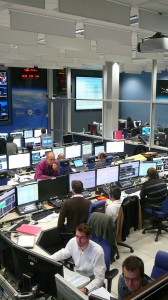This week is a “hard week” at ATV-CC in Toulouse, France, according to ESA Mission Director Daniel Firre. The joint ESA/CNES mission control team is undergoing three days of rigorous simulation training, in which teams must deal with a range of problems and contingency situations that may arise during the real mission, set for launch on 9 March.
“Today, ATV autonomously entered ‘survival mode’ – safe mode – just one minute after our until-then nominal docking. We don’t know why! We did not yet establish a cable power connection to the ISS, and the ATV solar panels are not getting much sunlight, so we’re on batteries and the clock is ticking. We have to figure out what caused the survival mode and fix the problem,” says Daniel, speaking during a very short lunch break.
The faults, of course, are all artificially injected into the mission control system (who have no warning or advance notice) by a team of simulation engineers working in a separate room. While stressful, the realistic training is designed to prepare the controllers to handle any possible contingency situation that may occur during the real mission.


 Automated Transfer Vehicle page
Automated Transfer Vehicle page ATV blog archive
ATV blog archive
Discussion: no comments